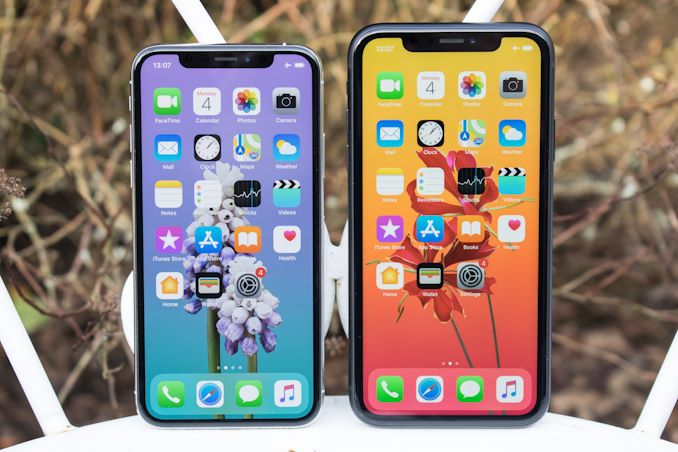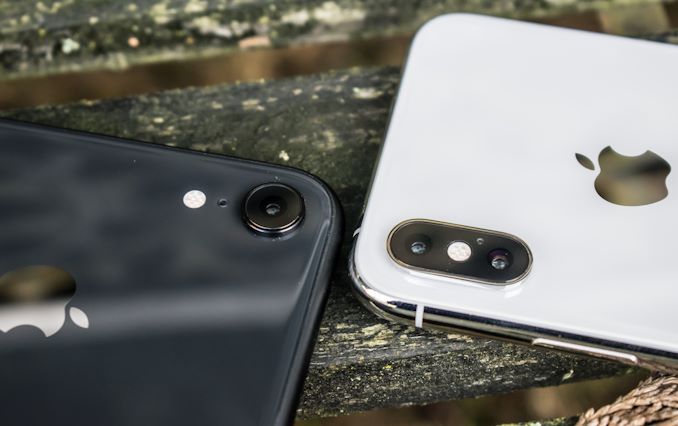The Apple iPhone XR Review: A Different Display Leads To Brilliant Battery Life
by Andrei Frumusanu on February 5, 2019 9:45 AM EST- Posted in
- Mobile
- Apple
- Smartphones
- iPhone XR
Conclusion & End Remarks
The iPhone XR is an interesting phone for Apple simply because of its price positioning. Starting at $749, it’s $250 cheaper than the base iPhone XS, and $350 cheaper than the iPhone XS Max. And this is a gap that continues straight up to the max capacity 256GB models. So the big question here for most users is if the iPhone XR’s differences represent reasonable compromises for the lower price.
From a design standpoint, the iPhone XR comes in the same industrial design as the iPhone XS variants – both of which follow up on the previous generation iPhone X. The big difference here is in the bezels, which are notably larger on the iPhone XR. It does not represent any deal-breaker for the phone and it’s something that I guess most users will get used to – but my gripe is still that with a $749 price tag, the design feels more like something that would have come from a budget smartphone. Apple’s choice of insisting on a symmetric bezel design isn’t something that I personally find appealing in this implementation – but I do know some other users prefer this kind of design over asymmetric bezels (though you could argue the notch makes it asymmetric anyhow…).
The one thing that surprised me the most when using the iPhone XR is that even though it’s a smaller phone than the XS Max, it doesn’t always actually feel all that smaller. Here the increased thickness of the phone does change the in-hand feel quite a lot, and it will feel bigger than you’d expect for a phone with its 75.7mm width.
The main (and most visible) difference between the XR and its XS is inarguably the screen. Among the reasons Apple is able to offer the XR at a cheaper price point is eschewing an OLED panel in favor of a more traditional LCD. In terms of the fundamentals of the LCD in the iPhone XR, Apple continues to employ some of the best panels in the industry, and the iPhone XR is no exception to this. Brightness, contrast ratio (for an LCD), viewing angles, and colour calibration are all top-notch and will not disappoint.
The one area where I think Apple went too conservative is with the display resolution. For the majority of users this will be a subjective matter and it will depend on how they use their phones, but I personally found it among the larger compromises made, and something that would be a deciding factor for me to opt against getting the XR. For anybody else who never use their phones closer than at arm’s length or are less sensitive to the resolution difference, it should not represent any major drawback.
With that said, Apple’s choice to go with an LCD display has a very important side-effect for the iPhone XR: because it avoids the double-edged sword that is a higher-end OLED, it also avoids the technology's higher base power consumption. This increased base power consumption was the reason why the XS Max lasted a notably shorter period of time than the iPhone 8 Plus. The iPhone XR avoids this problem, and in conjunction with the fantastic A12 SoC, the phone is able to achieve Apple’s best ever battery results in our tests. Lasting 25% longer than the iPhone XS Max, this represents a major improvement in battery life and is going to make all the difference for users who value it above everything else. For those users, the cheaper iPhone XR may very well be the better choice.
The performance of the iPhone XR is very much in line with the XS – meaning you’ll be getting an industry leading experience. An important factor for users who value gaming a lot is that, as a side-effect of the lower-resolution screen, the iPhone XR gets better GPU performance and better power efficiency as the phone is only pushing 44% of the pixels of the XS Max. This means longer gaming battery runtimes in current games, and better experiences in future, more demanding games.
The camera on the iPhone XR is pretty straightforward: It’s the same fantastic experience as on the iPhone XS, with the only difference being that it lacks the telephoto lens. Apple’s strengths here are their absolutely great capture experience, which is among the most consistent of current generation smartphones, as well as class-leading picture quality that ties with the best of the competition. Low-light performance is good, but as was the case with the XS, the Android handset vendors have seen immense jumps over the last year due to their usage of computational photography and better sensors, and it’s something that Apple just currently lags behind at.
The lack of a telephoto lens is one of the more justifiable compromises for the lower prices – it’s something that I might miss, but it’s also not a deal-breaker for the phone and I could very easily live without it.
Finally, the big question is if the iPhone XR represents a good value and if it’s a viable choice for users. I think the deciding factor for most users is whether they find the design/ergonomics of the phone acceptable, as well as the display's pixel density. If so, then the iPhone XR certainly seems to represent a better value than the XS alternatives.
Wrapping things up, I find myself coming back to my final paragraph of the iPhone XS review, where I had mentioned that Apple is asking for a lot of money for their new models. At the time I thought that this was a risky pricing strategy for the company, and it seems that Apple is feeling some of the side-effects here as smartphone revenue has dropped year-over-year.
Similarly, I think the iPhone XR is also priced a tad too high, and if you’re not entrenched in the iOS ecosystem, there are better value alternatives. I count myself among those who wouldn’t buy a smartphone at this price, and certainly not if it does compromise on some features. In a way this might be the rationale of more users, and that’s probably why the iPhone XR has seen less demand than anticipated. With hindsight, I see now what I might have been wrong in thinking the XR would be the most popular model of this generation, as it’s not priced low enough to convince users to drop down from what they see as the better long-term investment of an XS variant. That is if they would buy a new iPhone at all this generation, which with the ever increasing prices, is an ever increasingly hard choice to make.












89 Comments
View All Comments
Lolimaster - Thursday, February 7, 2019 - link
The resolution is just craptastic vs a 5.8" S9 where you can have TRUE 1080p RGB AMOLED when going 1080p in the options down from 1440 pentile mode.darkich - Thursday, February 7, 2019 - link
Wow, just wow.I find this comment to ironic because the only gripe I have with the XR is not the display not how ridiculously big bezels it has..as if it has a bumper case.
That some people can't see this is beyond me..
ss96 - Tuesday, February 5, 2019 - link
Hi Ian, do you have a number for the display's contrast ratio? Interested to know how it compares to previous iPhone LCDs.Also, what happened to the charts comparing contrast, color accuracy to the competing smartphones? Really miss those.
Andrei Frumusanu - Tuesday, February 5, 2019 - link
https://images.anandtech.com/doci/13912/XR-greysca...1450 to 1550:1 to depending on brightness.
As for the the accuracy charts, I think it lead to a lot of readers to too quickly jump to conclusions and misunderstand what the figures actually meant, and for example in the past we had some cases of phone A having a dE of say 2 vs a dE of 1 - in both cases the actual differences in this case are extremely small and in isolated conditions probably imperceptible. However because they had just looked up the chart they determined that phone B was that much better because the bar graphs were that much shorter. I think this was quite counter-productive to the analysis of some devices and something I wasn't that big of a fan of.
ss96 - Tuesday, February 5, 2019 - link
Hi Andrei, thanks for your answer. I liked those because it was easy to know what other devices scored without having to go to their respective review, but I understand that it may be misleading.MarcusMo - Wednesday, February 6, 2019 - link
I get what you mean regarding the dE comparison charts, however removing them all together seems like the nuclear option.Having review sites such as anandtech calling out poor accuracy again and again is part of the reason we’re seeing manufacturers finally care about this metric. Shaming them on a public comparison chart is a much more effective means towards that end then burying the numbers in each individual review.
A suggestion would be to include a cutoff line in the chart, declaring anything below this to be imperceptible to the human eye. That, and the Anandtech readerships ability to parse objective data (why we visit this site), should be enough to assuage any fears of misinterpretation.
mkozakewich - Wednesday, February 6, 2019 - link
You should turn those charts into some kind of logarithmic efficiency thing, where a dE of <=1 is 100% and a dE of 3 is 90%, or something like that.eastcoast_pete - Tuesday, February 5, 2019 - link
@Andrei: Thanks for this review. I largely agree with your analysis, but have an addition to your interpretation of Apple going below Full HD for the XR's display. Yes, build costs may well have been a little bit lower, but my suspicion is that, had the XR had even just an FHD display (otherwise identical in specs to the current one), the value proposition for the XS and XS Max would have been even more doubtful than it already is. Not that the XR is, by any means, a cheap phone - $ 749 for the 64GB entry-level model is a lot of money. But, I believe that Apple's decision to go with a below-FHD display for the XR was mainly to make it just that little less attractive so enough people still go for the premium models.fasterquieter - Tuesday, February 5, 2019 - link
I think the answer is much simpler. They determined years ago that 326ppi is sufficient as far as clarity goes. They have approaching a decade of software optimized for this 2X pixel count. Going slightly denser would have resulted in negligible image quality improvements and the need to downscale the image, like the Plus phones. That came with its own disadvantages. I think they made the right call.Zeross - Tuesday, February 5, 2019 - link
I think that you're perfectly right and In my opinion, something often overlooked is that the X and XS OLED displays are higher resolution mostly to compensate for the PenTile subpixels arrangement : the 458ppi figure is only true for green subpixels. Red and blue subpixels have a 324 sppi definition. So basically Apple have determined years ago that ~320ppi is good enough and the X (XS) screen resolution was chosen to ensure that all subpixels achieve this number. Of course I have no insight knowledge and I may be completely wrong but it would be a weird coincidence if by pure luck, the red and blue sppi of its latest phones is almost exactly the same that the one chosen in 2010 for the first retina iPhone.